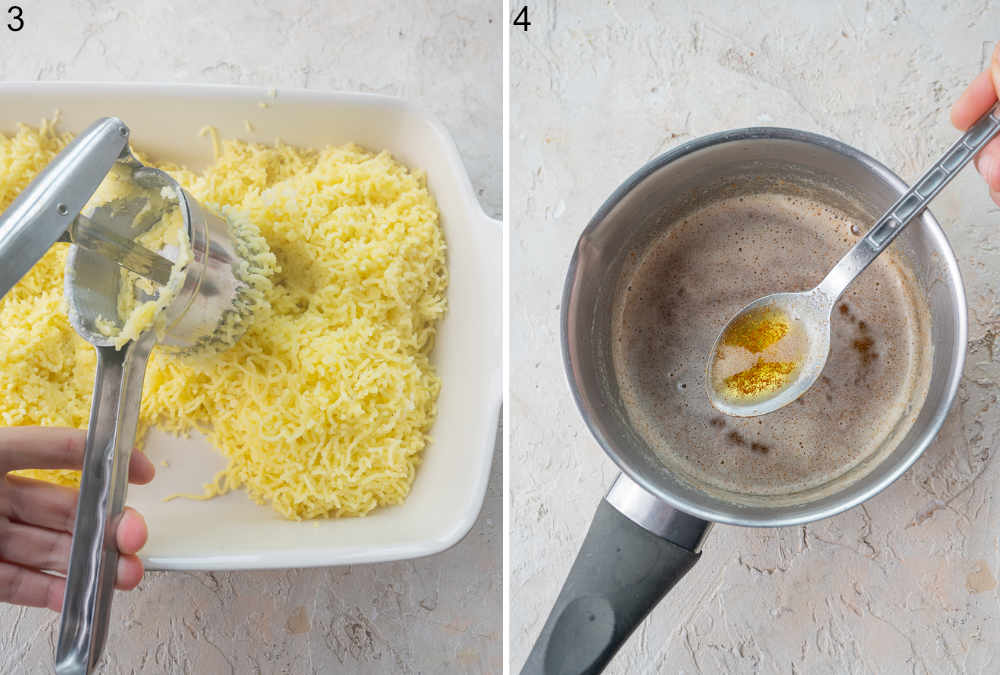This loaded mashed potato casserole makes an amazing side dish that can be easily made ahead or reheated. Fluffy delicious mashed potatoes are covered with cheddar cheese, baked until hot and creamy, and then topped with crispy bacon and chives.
You may also like these loaded smashed potatoes!

Ingredients
Below you will find information about the ingredients and how to prepare the recipe. For the measurements and detailed instructions scroll down to the printable recipe card.
Here’s what you need to make this amazing side dish:

- Potatoes – you want to use starchy/mealy potatoes such as Russets or your mashed potatoes will be gluey and far less creamy.
- Butter – we’re turning butter into brown butter for a more complex and delicious flavor.
- Garlic – the recipe calls for 8 cloves of garlic but don’t worry, it really won’t be too garlicky – boiled garlic loses its harsh flavor.
- Sour cream – essential for this recipe, it makes the mashed potatoes creamy and adds a pleasant, tangy flavor to them.
- Cream cheese – makes the mashed potatoes creamy but it could be omitted.
- Milk and heavy cream – you could also use half and half instead.
- Bacon – what doesn’t taste better with bacon? the best way to cook bacon is to bake it in the oven, but you could of course just cook it in a skillet. I’m adding the bacon just as a topping so it stays nice and crispy.
- Chives – I like to add chives to mashed potatoes but my kids don’t like them, that’s why I’m only using them as a topping. You could add some chives to the mashed potato mixture or even thinly sliced green onions.
- Cheddar cheese – adds an amazing flavor to the mashed potatoes. Freshly grated cheddar from a block tastes better than pre-shredded cheese.
How to make loaded mashed potato casserole step by step

STEP 1: Peel the potatoes (5 lbs or 2.2 kg) and cut them into even-sized chunks (about 1 1/2-inch or 4 cm). Add them to a large pot along with peeled 8 cloves garlic (don’t worry, the dish won’t be too garlicky). Pour cold water to cover the potatoes. Season the water well with salt. Bring to a boil then simmer for about 10-15 minutes or until the potatoes can be easily pierced with a fork.
STEP 2: While the potatoes are cooking, cook the bacon (5 oz or 145g) until crispy: either in a 400°F (200°C) oven for about 13-18 minutes (see this post for detailed instructions on how to bake bacon) or in a skillet on the stovetop.
I was short on time so I just quickly cooked bacon in a skillet but I prefer it from the oven – it’s more uniformly browned and crispy and there is no fat splatter.

STEP 3: Drain the potatoes on a sieve then return to the pot. Cook over low heat for 30-60 seconds, stirring, until all the remaining moisture is evaporated. Take off the heat.
Prepare a 9×13 inch (23x33cm) baking dish. Preheat the oven to 350°F (180°C).
Mash the potatoes and garlic cloves using a potato ricer or potato masher (potato ricer is best for fluffy mashed potatoes) directly into the baking dish.
STEP 4: Make brown butter: Add butter (1 stick + 2 tablespoons or 145g) to a medium saucepan and cook it over medium heat until it’s melted, then cook for 2-3 more minutes or until it’s golden brown and smells nutty. It should be just light golden brown and not dark golden brown. Reduce the heat when you see it’s starting to brown to avoid burning it.

STEP 5: Add the brown butter to the potatoes and stir to combine.
STEP 6: Add 1 cup (240ml) sour cream, 4 oz (115g) cream cheese, 3/4 cup (180ml) milk, and 3/4 cup (180ml) heavy cream to the same pot. Whisk until smooth and cook until very hot but not boiling.

STEP 7: Add the mixture to the potatoes and stir until combined. It will look soupy at first but the potatoes will absorb it all.
Shred 2 cups (200g) of cheddar on the large holes of a box grater.
Fold in about 1/3 of the shredded cheddar and season with salt and pepper to taste (if it’s missing some flavor, usually you just need to add more salt).
STEP 8: Even out the surface with a spatula. Top with the remaining cheese.
Cover the baking dish with aluminum foil and bake for 30 minutes. Remove the foil and bake for a further 10 minutes or until hot and bubbly.
Take out of the oven and top with cooked crumbled bacon. Put in the oven for 2-3 more minutes to warm up the bacon.
Sprinkle with chives just before serving.
Enjoy!

Storage
You can keep uncooked casserole in the fridge for up to 3 days and bake it when you’re ready to serve it. Add the bacon and chive topping directly before serving, do not store the casserole with the topping – it’s best freshly prepared.
After it has been baked, you can cover the dish loosely with a clean kitchen towel and it will still be warm even after 40 minutes (like above – add the bacon and chive topping directly before serving the dish).
You can keep cooked casserole in the fridge for up to 3 days. Reheat in 350°F (180°C) oven until warm. It also tastes very good reheated (bacon and chive topping won’t keep well though).
It’s better to store this casserole uncooked in the fridge and then bake it before you plan on serving it than baking it first and then reheating it.
This recipe can also be frozen (I have only tried to freeze baked casserole). Thaw in the fridge then reheat in the oven until warm through.
Top tips for the best mashed potatoes
- you can add more liquids to this mashed potato recipe if you’d like them even more creamy but I prefer not to do that – if made with too much dairy, the potatoes have a more pronounced dairy flavor instead of “potato flavor”
- a variety of potatoes really matters – use starchy/mealy potatoes for this recipe, such as Russets, Yukon Gold potatoes will also work but Russets are better
- use a potato ricer (and not a masher) for the fluffiest potatoes (but if you prefer chunkier mashed potatoes, you can go with the potato masher)
- stir riced potatoes with butter first, and then add the remaining ingredients
- making brown butter adds an additional step to the recipe but it really improves the flavor
- sour cream is the key for the best mashed potatoes
- cook the potatoes briefly in the pot after draining them to remove extra moisture from the potatoes
- start the potatoes in cold water – this way they will cook evenly
- potatoes should be evenly sized so they cook evenly
- don’t let the potatoes overcook
- don’t overmix the potatoes – stir all the ingredients just until combined, overmixed potatoes can end up gummy (also avoid using a stand or hand mixer)
- mash the potatoes while they’re still hot
More mashed potato recipes
- Make-Ahead Mashed Potatoes – a very similar recipe but without cheddar, chives, and bacon – it’s basically a basic mashed potato recipe that’s great to make ahead
- Cream Cheese Mashed Potatoes
- Cheddar mashed potatoes
- Sour cream mashed potatoes with chives

Did you make this recipe? RATE THE RECIPE or tell me in the COMMENTS how you liked it! You can also add a photo of your dish. It would make me very happy and will help other readers. Thank you!!
Loaded Mashed Potato Casserole
Ingredients
- 5 lbs (2.2 kg) Russet potatoes starchy potatoes
- 8 cloves garlic
- 1 stick + 2 tablespoons (145g) butter
- 1 cup (240ml) sour cream
- 4 oz (115g) cream cheese
- 3/4 cup (180ml) heavy cream
- 3/4 cup (180ml) milk
- 2 cups (200g) sharp cheddar cheese
- 5 oz (145g) bacon
- 1/4 cup chopped chives
- salt and pepper to taste
Would you like to save this?
Instructions
- Peel the potatoes and cut into even-sized chunks (about 1 1/2-inch or 4 cm). Add them to a large pot along with peeled cloves garlic (don’t worry, the dish won’t be too garlicky). Pour cold water to cover the potatoes. Season the water well with salt. Bring to a boil then simmer for about 10-15 minutes or until the potatoes can be easily pierced with a fork.5 lbs (2.2 kg) Russet potatoes, 8 cloves garlic
- While the potatoes are cooking, cook the bacon until crispy: either in a 400°F (200°C) oven for about 13-18 minutes (see this post for detailed instructions) or in a skillet on the stovetop (I prefer baking bacon).5 oz (145g) bacon
- Drain the potatoes on a sieve then return to the pot. Cook over low heat for 30-60 seconds, stirring, until all the remaining moisture is evaporated. Take off the heat.
- Prepare a 9×13 inch (23x33cm) baking dish. Preheat the oven to 350°F (180°C).
- Mash the potatoes and garlic cloves using a potato ricer or potato masher (potato ricer is best for fluffy mashed potatoes) directly into the baking dish.
- Make brown butter: Add butter to a medium saucepan and cook it over medium heat until it’s melted, then cook for 2-3 more minutes or until it’s golden brown and smells nutty. It should be just light golden brown and not dark golden brown. Reduce the heat when you see it’s starting to brown to avoid burning it.1 stick + 2 tablespoons (145g) butter
- Add the brown butter to the potatoes and stir to combine.
- Add sour cream, cream cheese, milk, and heavy cream to the same pot. Whisk until smooth and cook until very hot but not boiling.1 cup (240ml) sour cream, 4 oz (115g) cream cheese, 3/4 cup (180ml) heavy cream, 3/4 cup (180ml) milk
- Add the mixture to the potatoes and stir until combined. It will look soupy at first but the potatoes will absorb it all. Shred cheddar on the large holes of a box grater. Fold in about 1/3 of the shredded cheddar and season with salt to taste (if it's missing some flavor, usually you just need to add more salt).2 cups (200g) sharp cheddar cheese, salt and pepper to taste
- Even out the surface with a spatula. Top with the remaining cheese.
- Cover the baking dish with aluminum foil and bake for 30 minutes. Remove the foil and bake for a further 10 minutes or until hot and bubbly.
- Take out of the oven and top with cooked crumbled bacon. Put in the oven for 2-3 more minutes to warm up the bacon. Sprinkle with chives just before serving.1/4 cup chopped chives
- Enjoy!
Notes
- It’s better to store this casserole uncooked in the fridge and then bake it before you plan on serving it than baking it first and then reheating it.
- You can keep cooked casserole in the fridge for up to 3 days. Reheat in a 350°F (180°C) oven until warm. It tastes also very good reheated (top it with bacon and chives just before serving).
- Calories = 1 serving (1/10 of the recipe). This is only an estimate!






No Comments